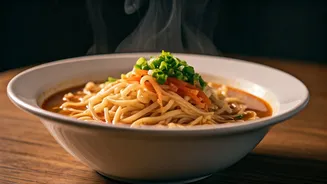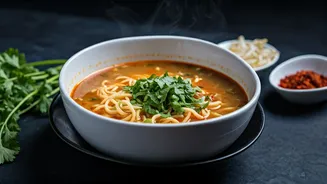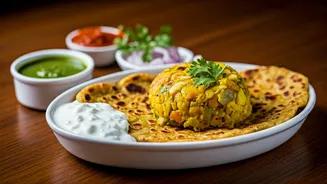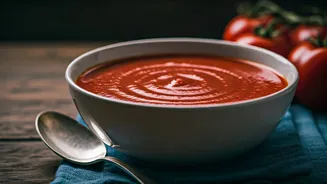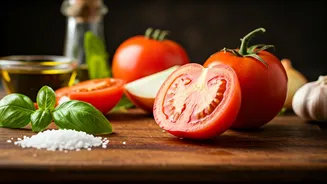Thukpa: Noodle Delight
Thukpa, a beloved noodle soup, stands out as a staple in Nepali cuisine, particularly during winter. Its origins trace back to Tibet, and it has found
a special place in the hearts (and stomachs) of many. A typical Thukpa features thick wheat noodles, often handmade, simmered in a savory broth. The broth itself can vary, sometimes clear and light, other times rich and intensely flavored. Besides noodles, the soup frequently includes vegetables like carrots, spinach, and cabbage, contributing to its nutritional profile. Cubes of tofu or meat, such as chicken or yak, might also be added, depending on regional preferences and dietary choices. Thukpa is customizable, with options to add chili for heat or a squeeze of lime to brighten the flavors, and this is what makes it a favorite across Nepal. Its warmth and heartiness make it an ideal meal on cold days.
Gundruk Soup: Fermented Flavor
Gundruk soup introduces a distinct fermented element, showcasing the Nepali appreciation for preserving and using seasonal ingredients. Gundruk, the key ingredient, consists of fermented leafy green vegetables, most commonly mustard greens, which undergo a natural fermentation process to develop their unique taste. This fermentation imparts a slightly sour and tangy flavor profile to the soup, setting it apart from other dishes. Preparing Gundruk soup usually involves simmering the fermented greens in a broth, often made with tomatoes, onions, and spices. The resulting soup tends to be hearty and packed with earthy flavors, representing a celebration of traditional cooking techniques. Often served with rice or bread, Gundruk soup provides a satisfying meal, especially when the weather turns cold.
Sel Roti Soup: Festive Touch
Sel Roti, a festive Nepali bread, might be best known as a sweet treat, but it can also be used in soup. Sel Roti is a ring-shaped rice flour doughnut. The soup, incorporating this iconic snack, reflects the adaptability of Nepali cuisine. The flavor of the soup itself may be customized depending on the event and season, incorporating regional spices and ingredients. The textures and flavors combined make this soup a wonderful way to enjoy Sel Roti. This soup often makes an appearance during celebrations and festivals, adding a comforting and familiar touch to the gathering. The presence of Sel Roti within the soup symbolizes both the resourceful use of ingredients and a deep cultural connection.
Tomato Soup: Simple Comfort
A simple tomato soup, though not uniquely Nepali in origin, holds a cherished spot in many households and restaurants in the country. This comforting dish brings a sense of warmth and familiarity to any table. Basic recipes typically involve cooking tomatoes with onions, garlic, and a blend of spices until they soften and blend together into a smooth, flavorful base. A touch of cream or butter sometimes enriches the flavor, while the addition of herbs like coriander or parsley introduces fresh aromatic notes. Often served with a side of bread for dipping, tomato soup provides a light yet satisfying meal, well-suited for a cold evening. Its simplicity and versatility make it a timeless classic.
Dal Soup: Lentil Nutrition
Dal soup, a staple across the Indian subcontinent and Nepal, showcases the nutritional value and versatility of lentils. Various types of lentils may be used, including red, yellow, or black lentils. Dal is typically simmered with onions, garlic, ginger, and a selection of spices, creating a rich and aromatic broth. Spices like turmeric, cumin, and coriander are often used to enhance the flavor. Dal soup is frequently served with rice or roti, forming a complete and balanced meal. The inclusion of lentils provides a good source of protein and fiber, making this soup a nourishing choice. It is a humble yet essential dish, reflecting the Nepali appreciation for simple, wholesome foods.
